COLOURS OF UTOPIA







Salt Contemporary Art in partnership with Everywhen Artspace

February 16-March 5, 2023
Design ©Lisa Reidy
Images ©The artists
Published by Everywhen Artspace & Salt Contemporary Art
Front: Belinda Golder Ngwarreye, My Country, 2023, acrylic on canvas, 100 x 150 cm (detail)
Left: Charmaine Pwerle, Awelye –Women’s Ceremony, 2022, acrylic on canvas, 94 x 100 cm (detail)
Over page: Selina Teece Pwerle, My Country, 2022, acrylic on linen, 100 x 150 cm (detail)
Text © Susan McCulloch
Belinda Golder Kngwarreye
Bernadine Kemarre
Caroline Petrick Ngwarreye
Charmaine Pwerle
Emily Pwerle
Esther Haywood Petyarre
Janet Golder Petyarre
Jeannie Mills Pwerle
Lizzie Moss Pwerle
Rochelle Bird Mbitjana
Selina Teece Pwerle
The art of Utopia, 230km northeast of Alice Springs, has been a major force in Australian art since the early 1990s, when women artists of the region began painting on canvas for the first time.
Most well-known is Emily Kame Kngwarreye whose work when she first started painting in the early 1990s attracted a huge response. Now, more than 30 years later, Kngwarreye’s work continues to garner ever growing international attention with her work on the secondary market maintaining the record as the highest of any Australian woman artist.
Significant in Emily Kame Kngwarreye’s paintings were her use of colour and bold, free imagery. Her work paved the way for other Aboriginal artists to forge their own individual styles and vibrant coloration.
Notable were Kngwarreye’s painting contemporaries who included Gloria Petyarre, Polly Ngale. Jeannie Mills Pwerle and Barbara Weir. As with Kngwarreye, vibrant colouration and highly individualistic imagery characterised their work.
Ever since, colour and highly individualistic design have been notable features in the work of Utopia’s women artists.
Belinda Golder Kngwarreye, Janet Golder Kngwarreye, Rochelle Bird Mbitjana
Belinda and Janet Golder Kngwarreye are the granddaughters of founding Utopia painters Polly Ngale.
Belinda’s works often feature the bush plum and the bush yam, The women of Utopia conduct ceremonies in tribute to the bush plum and bush yam to ensure their continued growth. Both she and her older sister Janet Golder Kngwarreye create works that represent a number of women’s stories of her Utopia country. Utopia is not one central community, but rather a collection of small homeland settlements established next to underground water bores across a vast area. It is this which has led to artists from different parts of Utopia developing their distinctively different styles. Janet and Belinda each pay tribute to these in their encyclopaedic paintings called My Country or Alhalkere- My Country. Janet’s daughter, Rochelle Bird Mbitjana is now following in her mother’s footsteps.
Esther Haywood Petyarre
The late artist Gloria Petyarre began a stylistic movement that continues until this day. In 1999, Petyarre became amongst the first Aboriginal artists to win a major award at an East Coast public Gallery when she won the Wynne Prize for Landscape Painting at the AGNSW with her multi-panel work, Leaves.
Petyarre’s granddaughter Esther Haywood continues her grandmother’s tradition – handling the skill of painterly movement as dextrously as Petyarre did, and continuing her significant work also as a colourist.
Emily Pwerle, Charmaine Pwerle, Lizzie Moss Pwerle
Emily Pwerle (now aged in her late 90s) is a sister to the late Minnie Pwerle, who became an art star in her 80s from 2006. Emily Pwerle continues to paint women’s stories of ceremony. Charmaine Pwerle – Minnie’s grand-daughter and Barbara Weir’s daughter – inherited her grandmother Minnie’s Awelye (women’s ceremonial stories) and brings her own energy and dynamism to paintings of Awelye. Lizzie Moss Pwerle is a first cousin of Minnie Pwerle and was part of Utopia’s early batik making projects. Her distinctive monochrome paintings depict the lines women paint on their bodies for ceremony.
Jeannie Mills Pwerle, Bernadine Kemarre, Caroline Petrick Ngwarreye, Lizzie Moss Pwerle, Selina Teece Pwerle
Senior artist Jeannie Mills Pwerle has become well known for her lush Yam dreaming paintings in which she loads the same brush with a mix of cleverly combined colours. Younger artists Bernadine Kemarre and Caroline Petrick Kngwarreye continue the tradition of bush medicine and seed dreaming paintings in new and distinctive styles while Selina Teece Pwerle creates luminous landscapes that depict the scale as well as detail of her beautiful lands.
Belinda uses a heavily loaded paint brush to work the many layers of colourful dots onto the linen to create the effect of the flowering plants, the scattered seeds of the Bush Plum and the landscape after the heavy rain season. The composition of colour and shape variations points to the geography and intimate knowledge of locations. The Bush Plum is of significance to the region of Utopia and the women who are attached to its Dreaming. The women celebrate the Bush Plum in their Awelye ceremonies.
 Belinda Golder Kngwarreye, Bush Plum, 2022, acrylic on linen, 113 x 200 cm, MM5994 | $4500
Belinda Golder Kngwarreye, Bush Plum, 2022, acrylic on linen, 113 x 200 cm, MM5994 | $4500
Belinda uses a heavily loaded paint brush to work the many layers of colourful dots onto the linen to create the effect of the flowering plants and the landscape after the heavy rain season. Here she depicts the blossoms of the native yam or Anaty of her region. The yam grows underground with a viny shrub growing above ground up to 1 metre high. It is normally found in near to acacia trees in the spinifexfilled sand plains. Its brilliant pink flowers emerge after the summer rain. The Anaty is a tuber (or swollen root) of the shrub and tastes like sweet potato. It can be eaten raw or cooked. There is also an ancient creation story that belongs to the Anaty, which women are taught as they enter initiation. The composition of colour and shape variations points to the geography and intimate knowledge of locations.
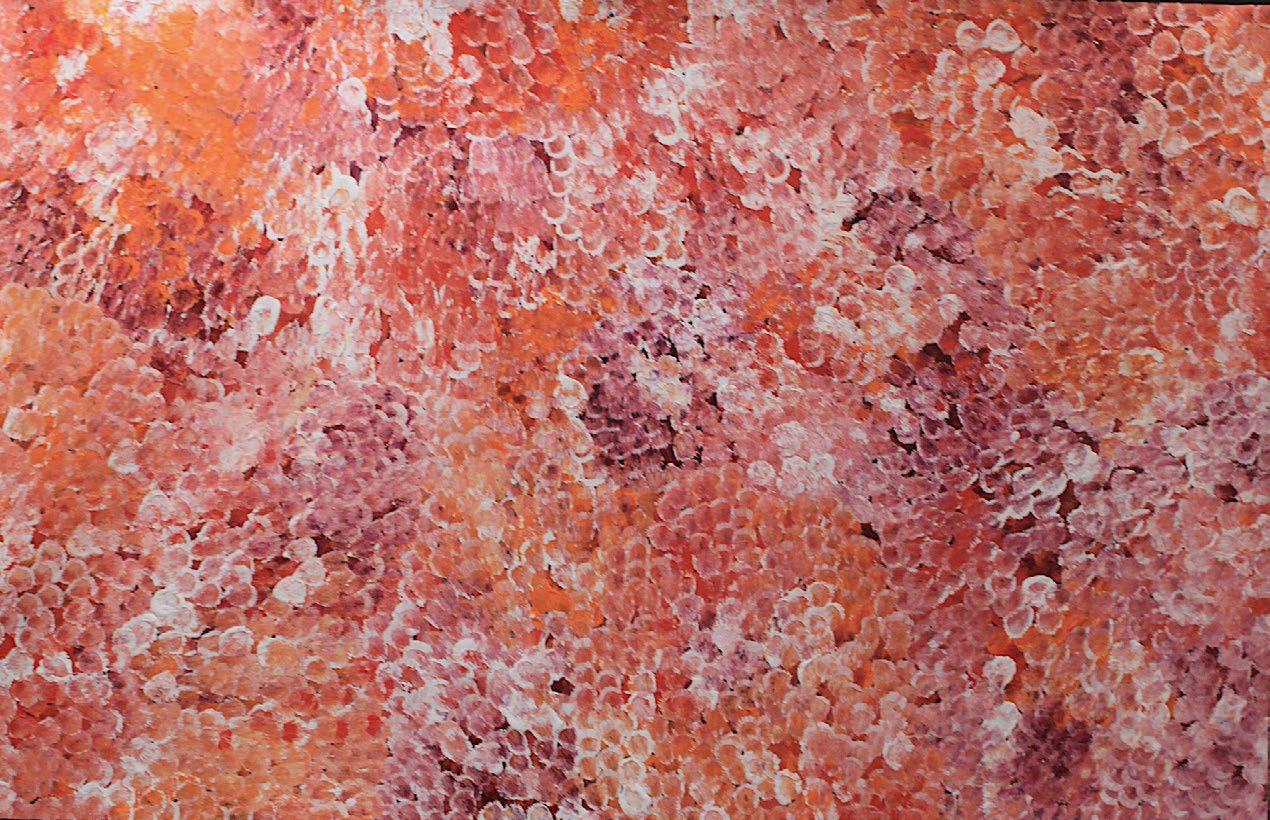 Belinda Golder Kngwarreye, Bush Yam Flower, 2022, acrylic on linen, 147 x 96 cm, MM6015 | $3200
Belinda Golder Kngwarreye, Bush Yam Flower, 2022, acrylic on linen, 147 x 96 cm, MM6015 | $3200
Belinda celebrates her country through depicting a number of its key women’s ancestral creation stories. These include bush melon, bush yam (of which she is a traditional custodian) and women’s ceremonies (awelye) in which women paint their bodies and perform songs and dances to bring fertility to the lands. Paintings of country often portray personal stories and memories of country that is significant to the artist. As well as women’s ancestral stories iconography of geographic elements within the desert landscape are depicted. These include rock holes, underground springs, mountain and rock formations, and sacred sites. These are meticulously recorded from memory and often depicted from an aerial perspective.
 Belinda Golder Kngwarreye, My Country, 2022, acrylic on linen, 94 x 149 cm, MM6032 | $3300
Belinda Golder Kngwarreye, My Country, 2022, acrylic on linen, 94 x 149 cm, MM6032 | $3300
Belinda celebrates her country through depicting a number of its key women’s ancestral creation stories. These include bush melon, bush yam (of which she is a traditional custodian) and women’s ceremonies (awelye) in which women paint their bodies and perform songs and dances to bring fertility to the lands. Paintings of country often portray personal stories and memories of country that is significant to the artist. as well as women’s ancestral stories iconography of geographic elements within the desert landscape are depicted. These include rock holes, underground springs, mountain and rock formations, and sacred sites. These are meticulously recorded from memory and often depicted from an aerial perspective.
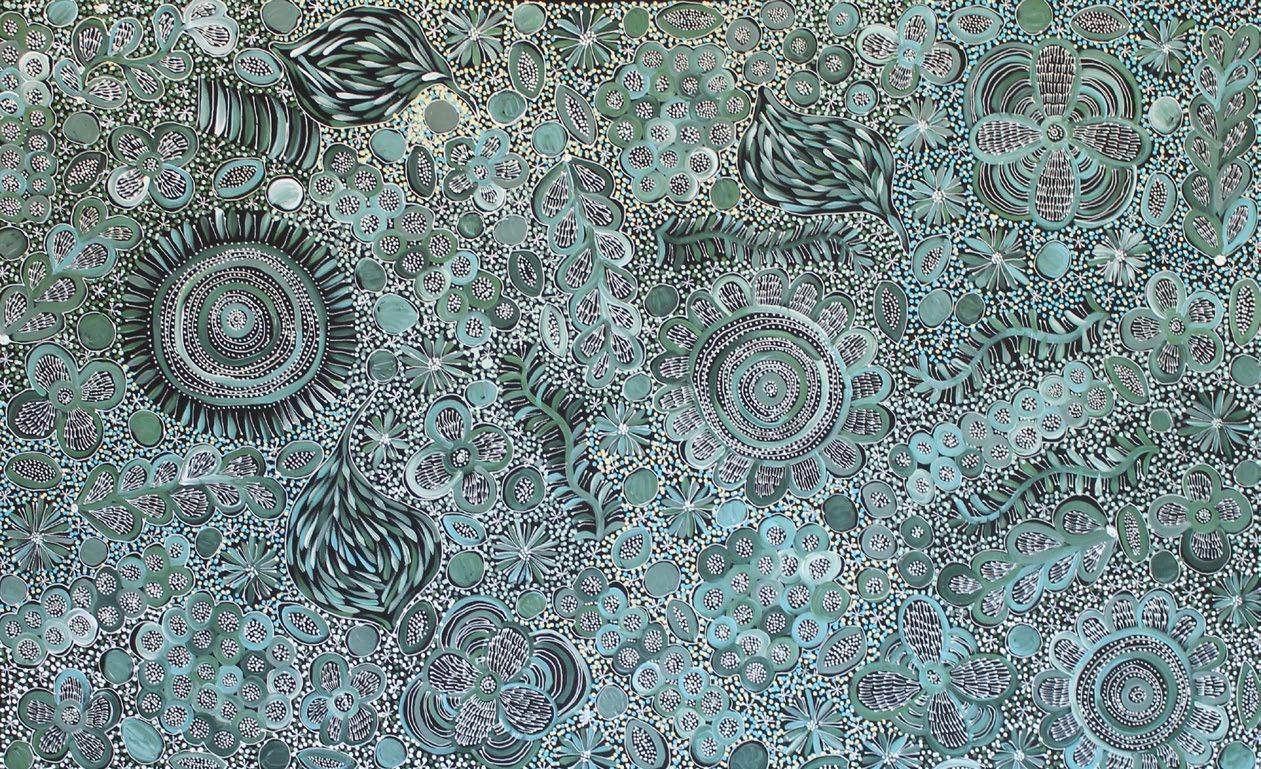 Belinda Golder Kngwarreye, Alhalkere – My Country, 2022, acylic on linen, 96 x 154 cm, MM6810 | $3300
Belinda Golder Kngwarreye, Alhalkere – My Country, 2022, acylic on linen, 96 x 154 cm, MM6810 | $3300
Belinda uses a heavily loaded paint brush to work the many layers of colourful dots onto the linen to create the effect of the flowering plants and the landscape after the heavy rain season. Here she depicts the blossoms of the native yam or Anaty of her region. The yam grows underground with a viny shrub growing above ground up to 1 metre high. It is normally found in near to acacia trees in the spinifexfilled sand plains. Its brilliant pink flowers emerge after the summer rain. The Anaty is a tuber (or swollen root) of the shrub and tastes like sweet potato. It can be eaten raw or cooked. There is also an ancient creation story that belongs to the Anaty, which women are taught as they enter initiation. The composition of colour and shape variations points to the geography and intimate knowledge of locations.
 Belinda Golder Kngwarreye, Bush Yam Flowers, 2022, acrylic on linen, 71 x 118 cm, MM6813 | $2000
Belinda Golder Kngwarreye, Bush Yam Flowers, 2022, acrylic on linen, 71 x 118 cm, MM6813 | $2000
Belinda uses a heavily loaded paint brush to work the many layers of colourful dots onto the linen to create the effect of the flowering plants, the scattered seeds of the Bush Plum and the landscape after the heavy rain season. The composition of colour and shape variations points to the geography and intimate knowledge of locations. The Bush Plum is of significance to the region of Utopia and the women who are attached to its Dreaming. The women celebrate the Bush Plum in their Awelye ceremonies.
 Belinda Golder Kngwarreye, Bush Plum Flowers, 2021, acrylic on linen, 187 x 199 cm, MM6816 | $5400
Belinda Golder Kngwarreye, Bush Plum Flowers, 2021, acrylic on linen, 187 x 199 cm, MM6816 | $5400
Belinda uses a heavily loaded paint brush to work the many layers of colourful dots onto the linen to create the effect of the flowering plants and the landscape after the heavy rain season. Here she depicts the blossoms of the native yam or Anaty of her region. The yam grows underground with a viny shrub growing above ground up to 1 metre high. It is normally found in near to acacia trees in the spinifexfilled sand plains. Its brilliant pink flowers emerge after the summer rain. The Anaty is a tuber (or swollen root) of the shrub and tastes like sweet potato. It can be eaten raw or cooked. There is also an ancient creation story that belongs to the Anaty, which women are taught as they enter initiation. The composition of colour and shape variations points to the geography and intimate knowledge of locations.
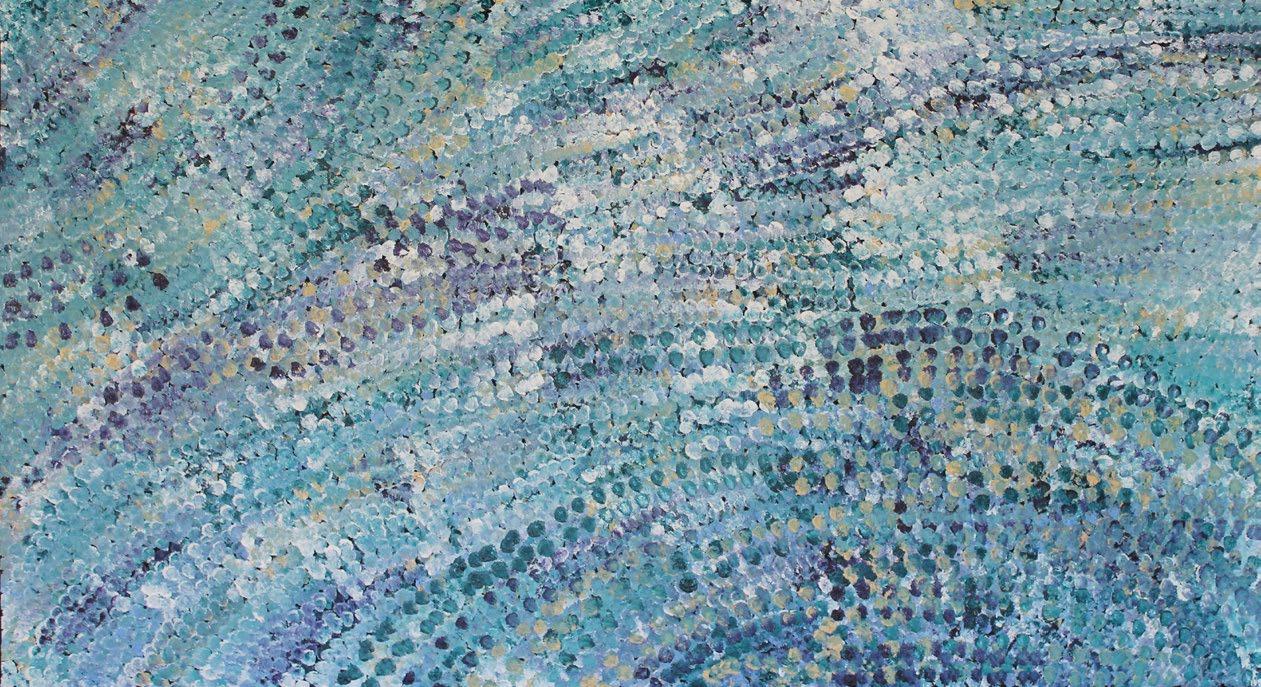 Belinda Golder Kngwarreye, Bush Yam Flowers, 2021, acrylic on linen, 110 x 200 cm, MM6819 | $4700
Belinda Golder Kngwarreye, Bush Yam Flowers, 2021, acrylic on linen, 110 x 200 cm, MM6819 | $4700
Belinda celebrates her country through depicting a number of its key women’s ancestral creation stories. These include bush melon, bush yam (of which she is a traditional custodian) and women’s ceremonies (awelye) in which women paint their bodies and perform songs and dances to bring fertility to the lands. Paintings of country often portray personal stories and memories of country that is significant to the artist. as well as women’s ancestral stories iconography of geographic elements within the desert landscape are depicted. These include rock holes, underground springs, mountain and rock formations, and sacred sites. These are meticulously recorded from memory and often depicted from an aerial perspective.
 Belinda Golder Kngwarreye, My Country, 2022, acrylic on linen, 102 x 112 cm, MM6829 | $2900
Belinda Golder Kngwarreye, My Country, 2022, acrylic on linen, 102 x 112 cm, MM6829 | $2900
Bernadine Kemarre follows the great tradition of many of Utopia’s famous women artists such as Gloria Petyarre whose paintings are of bush medicine leaves, bush tucker and other plants of her lands. The style of her bush medicine leaves paintings is highly detailed and she is a skilled colourist, blending many shades of similar or complementary colours together with great skill. Bush Medicine Leaves are collected by the women and are used in a variety of different ways. They can be boiled in water and the liquid used as a drinking medicine. This medicine can ease stomach ache. The leaves can also be crushed and mixed with Kangaroo Fat to create a salve that is applied to burns. As a bush woman, Bernadine is familiar with her land and its abundance of bush tucker species, medicine plants and native fauna. These are the stories inherited by her, along with important women’s stories. Both of these form the basis of her paintings. Since she started painting in the late 1990s, Bernadine’s work has become highly refined and is eagerly sought after by collectors and art enthusiasts throughout Australia and internationally.

Bernadine Kemarre follows the great tradition of many of Utopia’s famous women artists such as Gloria Petyarre whose paintings are of bush medicine leaves, bush tucker and other plants of her lands. The style of her bush medicine leaves paintings is highly detailed and she is a skilled colourist, blending many shades of similar or complementary colours together with great skill. Bush Medicine Leaves are collected by the women and are used in a variety of different ways. They can be boiled in water and the liquid used as a drinking medicine. This medicine can ease stomach ache. The leaves can also be crushed and mixed with Kangaroo Fat to create a salve that is applied to burns. As a bush woman, Bernadine is familiar with her land and its abundance of bush tucker species, medicine plants and native fauna. These are the stories inherited by her, along with important women’s stories. Both of these form the basis of her paintings. Since she started painting in the late 1990s, Bernadine’s work has become highly refined and is eagerly sought after by collectors and art enthusiasts throughout Australia and internationally.

Caroline Petrick Ngwarreye’s traditional country is Irrerlirre approximately 250km north east of Alice Springs in the beautiful Harts Range. Caroline developed her artistic talents under the tutelage of her mother Jill Kelly Kemarre. Her subtle paintings of intricate patterns of dot work and splashes of colour relate to her mother’s country and stories from Irrwelty. These stories include arnwekety – conkerberry, ntange – seeds and awelye – women’s ceremony. A drive through this country would take you through wide open plains of red sand and spinifex grass, wooded areas of mulga shrubs, whilst occasionally crossing dry sandy river beds, their banks shaded by the majestic red river gums. Rocky outcrops hide precious underground water soaks and rock holes. After a season of good rain, alpitye (bush flowers) burst out in fields of colour.
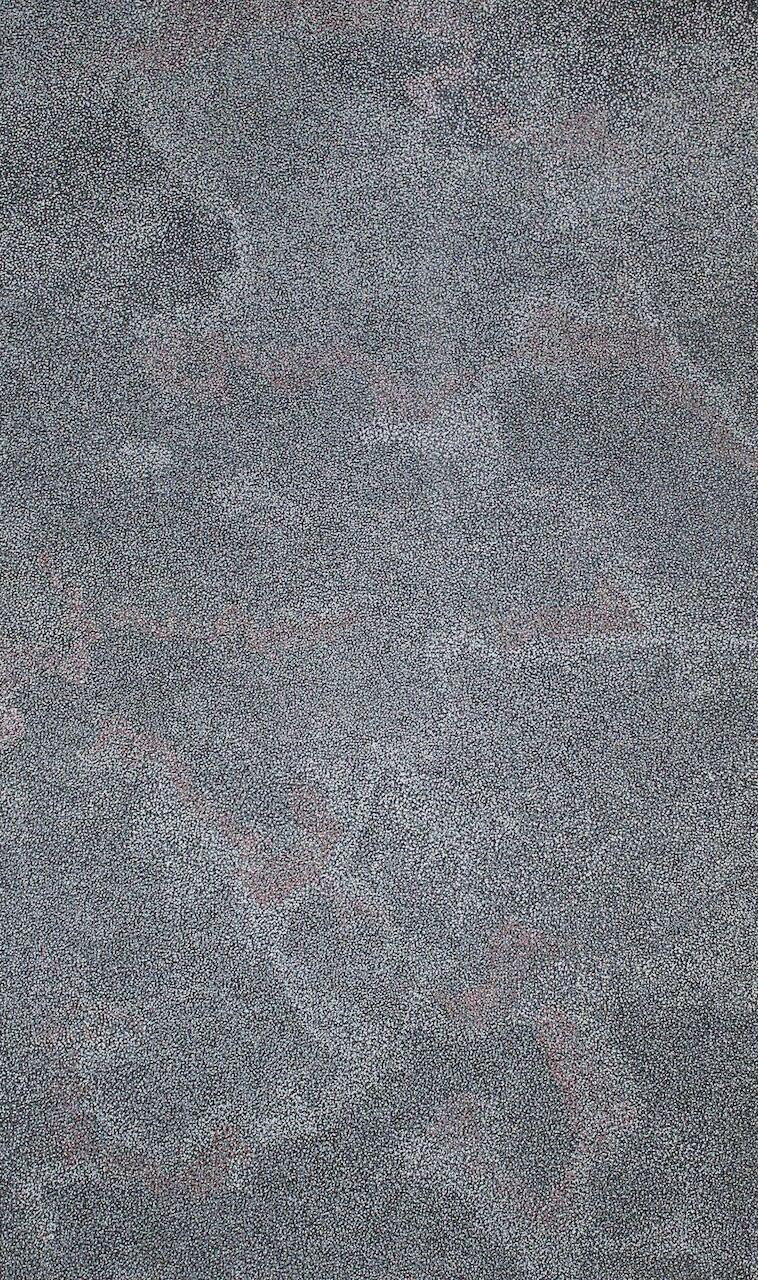 Caroline Petrick Ngwarreye, Amper Achinya – My Beautiful Country, 2022, acrylic on linen, 150 x 90 cm, MM6018 | $4300
Caroline Petrick Ngwarreye, Amper Achinya – My Beautiful Country, 2022, acrylic on linen, 150 x 90 cm, MM6018 | $4300
Charmaine Pwerle inherited the rights to paint the women’s ceremonial and dreaming stories of her grandmother, the late Minnie Pwerle whom she spent much time as a young woman. The large circular images in her paintings represents ceremonial sites, the linear design represents the tracks used when searching for food. The small circular designs are the seeds of the bush melon seed and the curvilinear shapes depict ‘Awelye’ or women’s ceremonial body-paint design.
 Charmaine Pwerle, Awelye, 2022, acrylic on linen, 90 x 120 cm, MM6793 | $3500
Charmaine Pwerle, Awelye, 2022, acrylic on linen, 90 x 120 cm, MM6793 | $3500
Charmaine Pwerle inherited the rights to paint the women’s ceremonial and dreaming stories of her grandmother, the late Minnie Pwerle whom she spent much time as a young woman. The large circular images in her paintings represents ceremonial sites, the linear design represents the tracks used when searching for food. The small circular designs are the seeds of the bush melon seed and the curvilinear shapes depict ‘Awelye’ or women’s ceremonial body-paint design.
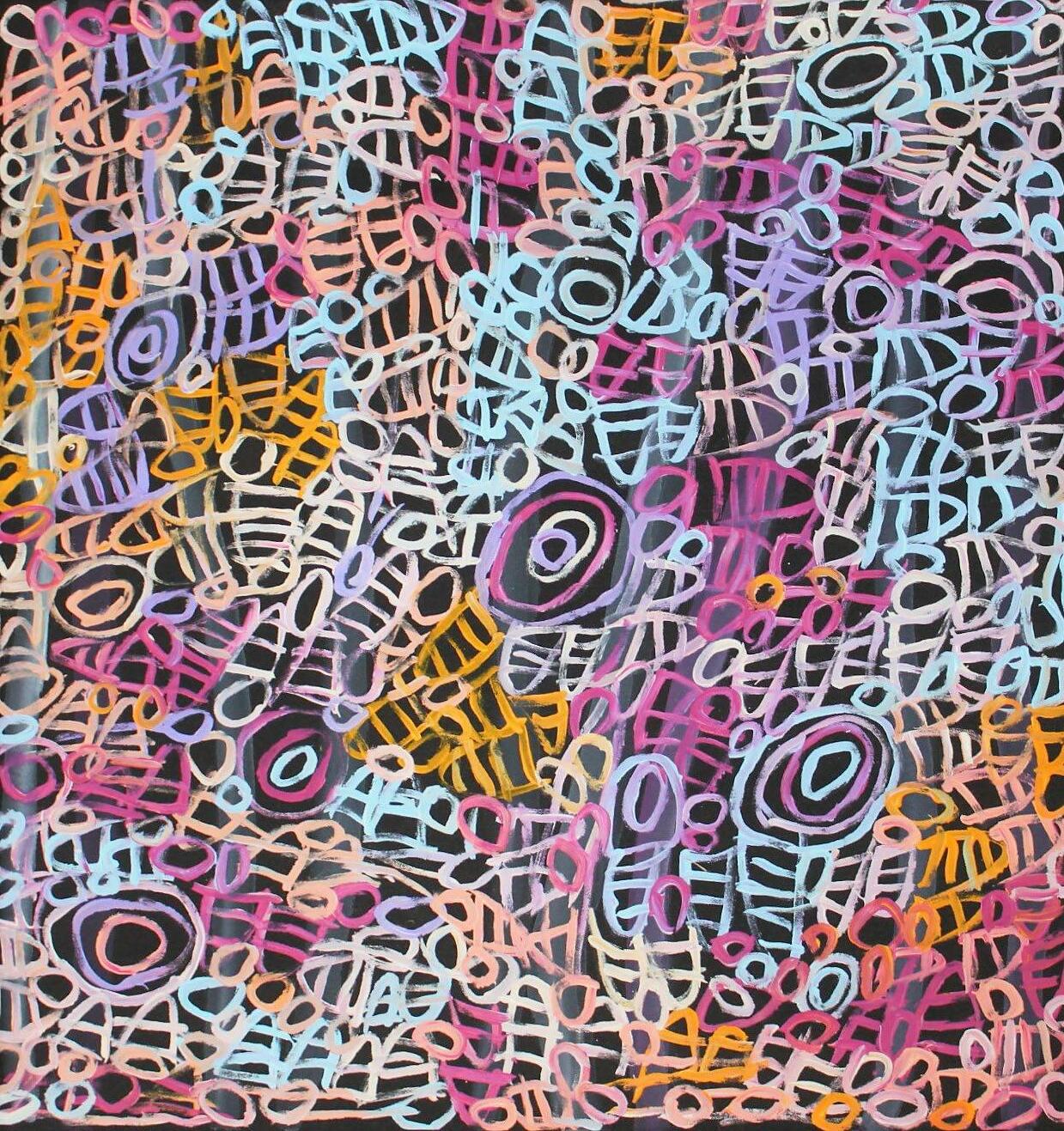 Charmaine Pwerle, Awelye – Women’s Ceremony, 2022, acrylic on linen, 94 x 100 cm, MM6794 | $2900
Charmaine Pwerle, Awelye – Women’s Ceremony, 2022, acrylic on linen, 94 x 100 cm, MM6794 | $2900
Senior artist Emily Pwerle paints Awelye Atnwengerrp, meaning women’s ceremony, which is depicted by a series of lines and symbols, often criss-crossed patterns that are layered across the canvas with colours that are explosive, colourful and energetic. The patterns represent the designs painted on women’s bodies during bush tucker ceremonies in Atnwengerrp. In Pwerle’s painting the body painting designs are dense - they jostle for space, as though they were about to break from their rectangular restraints and explode forth in a riot of colour and pattern.
 Emily Pwerle, Awelye – Women’s Ceremony, 2022, acrylic on canvas, 70 x 100 cm, MM6789 | $2200
Emily Pwerle, Awelye – Women’s Ceremony, 2022, acrylic on canvas, 70 x 100 cm, MM6789 | $2200
Esther Haywood Petyarre is the grand-daughter of healer and painter Gloria Petyarre. She learnt to paint from her grandmother and has inherited the rights to paint her grandmother’s famous depictions of bush medicine leaves, and the dreaming stories they represent.
 Esther Haywood Petyarre, Leaves, 2021, acrylic on linen, 89 x 71 cm, MM5664 | $1200
Esther Haywood Petyarre, Leaves, 2021, acrylic on linen, 89 x 71 cm, MM5664 | $1200
Here Janet Golder Kngwarreye celebrates her country through depicting a number of its key women’s ancestral creation stories. These include bush melon, bush yam (of which she is a traditional custodian) and women’s ceremonies (awelye) in which women paint their bodies and perform songs and dances to bring fertility to the lands. Paintings of country often portray personal stories and memories of country that is significant to the artist. as well as women’s ancestral stories iconography of geographic elements within the desert landscape are depicted. These include rock holes, underground springs, mountain and rock formations, and sacred sites. These are meticulously recorded from memory and often depicted from an aerial perspective.
 Janet Golder Kngwarreye, My Country Alhalkerre, 2022, acrylic on linen, 80 x 96 cm, MM6013 | $2400
Janet Golder Kngwarreye, My Country Alhalkerre, 2022, acrylic on linen, 80 x 96 cm, MM6013 | $2400
Here Janet Golder Kngwarreye celebrates her country through depicting a number of its key women’s ancestral creation stories. These include bush melon, bush yam (of which she is a traditional custodian) and women’s ceremonies (awelye) in which women paint their bodies and perform songs and dances to bring fertility to the lands. Paintings of country often portray personal stories and memories of country that is significant to the artist. as well as women’s ancestral stories iconography of geographic elements within the desert landscape are depicted. These include rock holes, underground springs, mountain and rock formations, and sacred sites. These are meticulously recorded from memory and often depicted from an aerial perspective.
 Janet Golder Kngwarreye, Alhalkerre – My Father’s Country, 2022, acrylic on linen, 130 x 200 cm, MM6034 | $6900
Janet Golder Kngwarreye, Alhalkerre – My Father’s Country, 2022, acrylic on linen, 130 x 200 cm, MM6034 | $6900
Here Janet Golder Kngwarreye celebrates her country through depicting a number of its key women’s ancestral creation stories. These include bush melon, bush yam (of which she is a traditional custodian) and women’s ceremonies (awelye) in which women paint their bodies and perform songs and dances to bring fertility to the lands. Paintings of country often portray personal stories and memories of country that is significant to the artist. as well as women’s ancestral stories iconography of geographic elements within the desert landscape are depicted. These include rock holes, underground springs, mountain and rock formations, and sacred sites. These are meticulously recorded from memory and often depicted from an aerial perspective.
 Janet Golder Kngwarreye, My Country, 2022, acrylic on linen, 96 x 150 cm, MM6806 | $3200
Janet Golder Kngwarreye, My Country, 2022, acrylic on linen, 96 x 150 cm, MM6806 | $3200
Here Janet Golder Kngwarreye celebrates her country through depicting a number of its key women’s ancestral creation stories. These include bush melon, bush yam (of which she is a traditional custodian) and women’s ceremonies (awelye) in which women paint their bodies and perform songs and dances to bring fertility to the lands. Paintings of country often portray personal stories and memories of country that is significant to the artist. as well as women’s ancestral stories iconography of geographic elements within the desert landscape are depicted. These include rock holes, underground springs, mountain and rock formations, and sacred sites. These are meticulously recorded from memory and often depicted from an aerial perspective.
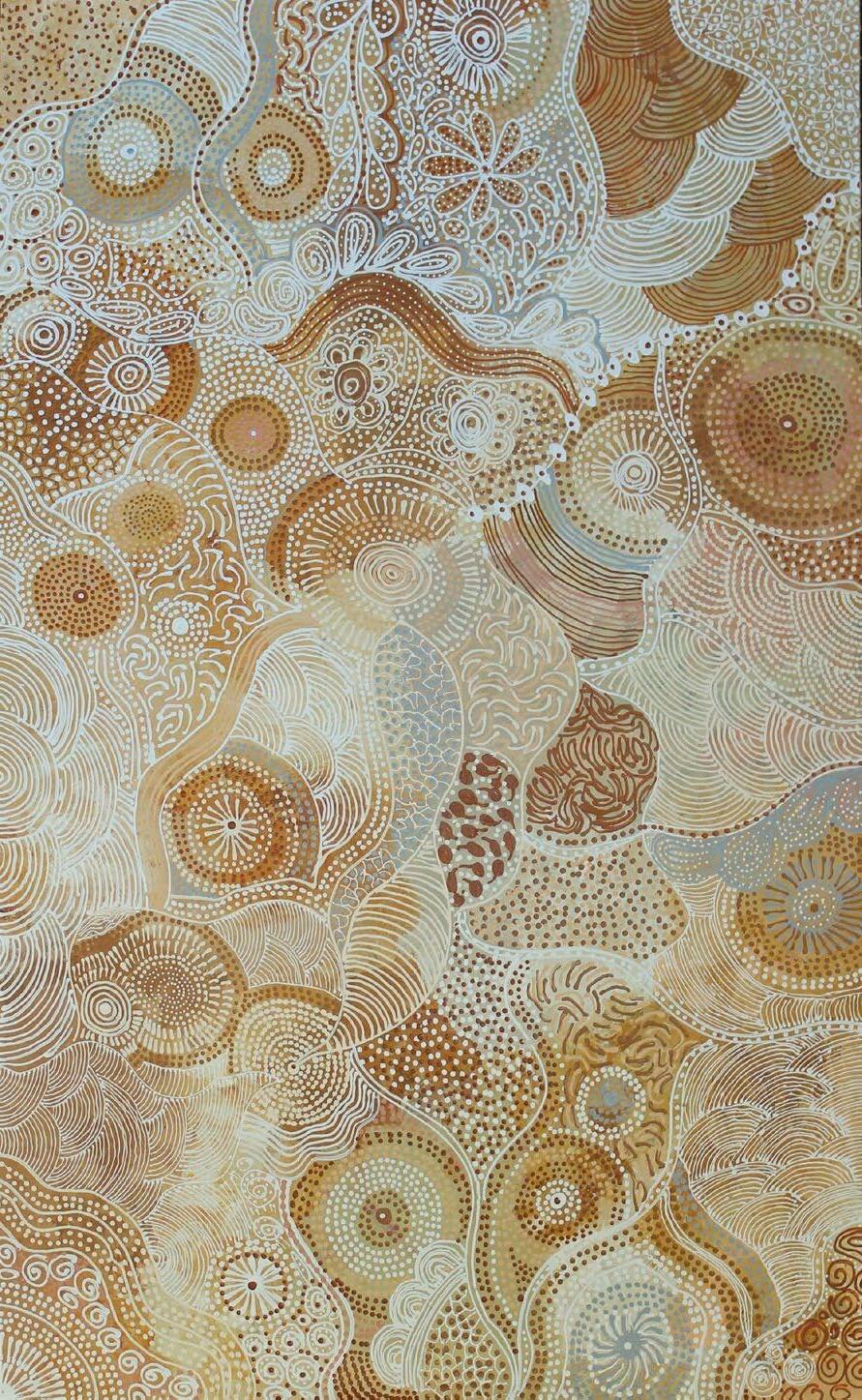 Janet Golder Kngwarreye, Alhalkerre – My Country, 2022, acrylic on linen, 130 x 80 cm, MM6807 | $2700
Janet Golder Kngwarreye, Alhalkerre – My Country, 2022, acrylic on linen, 130 x 80 cm, MM6807 | $2700
Senior artist Jeannie Mills Pwerle’s paintings predominately represent the Anaty - or native yam which grows in her region. The yam grows underground with a viny shrub growing above ground up to 1 metre high. It is normally found near to acacia trees in the spinifex-filled sand plains. Its brilliant pink flowers emerge after the summer rain. The Anaty is a tuber (or swollen root) of the shrub and tastes like sweet potato. It can be eaten raw or cooked. The linear work in Jeannie’s artworks represent the root system of the yam, and her dots, its seeds.
There is an ancient creation story that belongs to the Anaty, which women are taught as they enter initiation. By depicting the Anaty Jeannie pays homage to this significant plant and encourages its continual rejuvenation. Using a variety of colours in each brush stroke, Jeannie builds up a pattern of harmonious or contrasting colours, outlined by fine white dots and executed with great skill.
 Jeannie Mills Pwerle, Yam Dreaming, 2022, acrylic on linen, 100 x 150 cm, MM6121 | $3400
Jeannie Mills Pwerle, Yam Dreaming, 2022, acrylic on linen, 100 x 150 cm, MM6121 | $3400
Senior artist Lizzie Moss Pwerle’s painting depicts Awelyeor women’s ceremony – in which women paint themselves up and perform ceremonies to ensure the fertility of the land, its plants and animals.
The lines in this painting are reminiscent of the patterns the women paint on their bodies and the lines in the sand they make while dancing the ceremony.
 Lizzie Moss Pwerle, Dancing Lines, 2022, acrylic on linen, 100 x 120 cm, MM6792 | $3200
Lizzie Moss Pwerle, Dancing Lines, 2022, acrylic on linen, 100 x 120 cm, MM6792 | $3200
Rochelle Bird Mbitjana is the eldest child of leading Utopia artist Janet Golder Kngwarreye and the niece of artist Belinda Golder Kngwarreye. She has inherited the rights to paint her mother’s stories of her country and is regarded as a highly talented young emerging artist.
 Rochelle Bird Mbitjana, My Grandfather’s Country, 2022, acrylic on linen, 96 x 100 cm, MM6800 | $1600
Rochelle Bird Mbitjana, My Grandfather’s Country, 2022, acrylic on linen, 96 x 100 cm, MM6800 | $1600
Selina Teece Pwerle grew up surrounded by artists and amidst the growing interest in art from the Utopia region. She developed her own artistic talents as a young woman and has developed her own unique styles to represent the plants, flowers, and landscapes of her country. She especially paints her country after rains when it is blanketed with lush grasses and flowers.
In brilliant colour and precise detail, her expansive vistas depict the rivers, red earth, trees, flowers, hills and the everchanging light of the Outback with an intimacy born of her own observations and lifelong knowledge of these lands and that of her forebears who have lived on them for millennia.
 Selina Teece Pwerle, My Father’s Country, 2022, acrylic on linen, 45 x 90 cm, MM6796 | $2000
Selina Teece Pwerle, My Father’s Country, 2022, acrylic on linen, 45 x 90 cm, MM6796 | $2000
Selina Teece Pwerle grew up surrounded by artists and amidst the growing interest in art from the Utopia region. She developed her own artistic talents as a young woman and has developed her own unique styles to represent the plants, flowers, and landscapes of her country. She especially paints her country after rains when it is blanketed with lush grasses and flowers.
In brilliant colour and precise detail, her expansive vistas depict the rivers, red earth, trees, flowers, hills and the everchanging light of the Outback with an intimacy born of her own observations and lifelong knowledge of these lands and that of her forebears who have lived on them for millennia.
 Selina Teece Pwerle, My Country, 2022, acrylic on linen, 70 x 100 cm, MM6797 | $3200
Selina Teece Pwerle, My Country, 2022, acrylic on linen, 70 x 100 cm, MM6797 | $3200
Selina Teece Pwerle grew up surrounded by artists and amidst the growing interest in art from the Utopia region. She developed her own artistic talents as a young woman and has developed her own unique styles to represent the plants, flowers, and landscapes of her country. She especially paints her country after rains when it is blanketed with lush grasses and flowers.
In brilliant colour and precise detail, her expansive vistas depict the rivers, red earth, trees, flowers, hills and the everchanging light of the Outback with an intimacy born of her own observations and lifelong knowledge of these lands and that of her forebears who have lived on them for millennia.
 Selina Teece Pwerle, My Country, 2022, acrylic on linen, 100 x 150 cm, MM6798 | $6600
Selina Teece Pwerle, My Country, 2022, acrylic on linen, 100 x 150 cm, MM6798 | $6600
Belinda Golder Kngwarreye was born in 1986 and is an Anmatyerre speaker from the Utopia region of Central Australia, situated approximately 130km north-east of Alice Springs. Belinda comes from a long line of significant and well-established artists. She is the daughter of Bessie Petyarre; her sister is Janet Golder Kngwarreye and both artists are the grandaughters of Polly Ngale. Her great aunts are artists Kathleen Ngale and Angelina Ngale. In her depictions of the seeds, flowers and fruit of the bush plum –an important dreaming story as well as food source for her people. Belinda is following in the footsteps of these, and other highly regarded artists of the Kngwarreye family, especially Emily Kame Kngwarreye, and Kudditji Kngwarreye.
Bernadine Kemarre is an Arrernte woman born in 1974 at Santa Teresa, NT. She moved to the Eastern Desert community of Utopia to marry Stephen Price Pitjarra the brother of well known artist Anna Price Petyarre. In her art Bernadine follows the great tradition of many of Utopia’s famous women artists such as Gloria Petyarre whose paintings are of


bush medicine leaves, bush tucker and other plants of her lands. The style of her bush medicine leaves paintings is highly detailed and she is a skilled colourist, blending many shades of similar or complementary colours together with great skill. Bush Medicine

Leaves are collected by the women and are used in a variety of different ways. They can be boiled in water and the liquid used as a drinking medicine. This medicine can ease stomach-ache. The leaves can also be crushed and mixed with Kangaroo Fat to create a salve that is applied to burns. As a bush woman, Bernadine is familiar with her land and its abundance of bush tucker species, medicine plants and native fauna. These are the stories inherited by her, along with important women’s stories, and which form the basis of her paintings. Since she started painting in the late 1990s, Bernadine’s work has become more refined and is eagerly sought after by collectors and art enthusiasts throughout Australia and internationally.
Caroline Petrick Ngwarreye is an Eastern Arrernte and Alyawarr women born c 1966. Her traditional country is Irrerlirre approximately 250km northeast of Alice Springs in the beautiful Harts Range. Caroline developed her artistic talents under the tutelage of her mother Jill Kelly Kemarre. Her subtle paintings of
intricate patterns of dot work and splashes of colour relate to her mother’s country and stories from Irrwelty. These stories include arnwekety – conkerberry, ntange – seeds and awelye – women’s ceremony. The intricate pattern of dot and line work throughout Caroline’s painting reflects her mother’s traditional country Irrwelty, which lies on Alyawarre land approximately 300 kms north east of Alice Springs in Central Australia.
Charmaine Pwerle is an Anmatyerre woman born in Alice Springs in 1976. She grew up on the Utopia homelands and went to school in Adelaide as well as living and working in Melbourne before returning to live in Alice Springs and her Utopia lands. Her mother is famed painter Barbara Weir and her grandmother the equally famous Minnie Pwerle - the rights to whose stories she has inherited and which she paints. Other famous women painters close to Charmaine include her great aunts Emily, Galya and Molly Pwerle and her extended family relatives Gloria Petyarre and the late Emily Kame Kngwarreye. A fully initiated woman, Charmaine has four children and lives at Irrultja on the Utopia lands. Always a talented artist her work has developed a great vivacity and surety as she herself matures and has the rights, through initiation and heritage, to paint the stories and the country of her grandmother, Minnie

Pwerle with whom she spent much time as a young woman. The large circular images in her paintings represents ceremonial sites, the linear design represents the tracks used when searching for food. The small circular designs are the seeds of the bush melon seed and the curvilinear shapes depict ‘Awelye’ or women’s ceremonial body-paint design. Charmaine Pwerle’s work is highly sought after by galleries and collectors.
Emily Pwerle’s country is Atnwengerrp and her languages are Anmatyerre and Alyawarr. She was possibly born in the early 1930s (no records exist) and lives in Irrultja, a tiny settlement in Utopia of about 100 people. She has had little exposure to western culture and only picked up a paintbrush for the first time in 2004. Sister of the late Minnie Pwerle, Emily Pwerleʼs extended family are all artists: Barbara Weir, Aileen and Betty Mpetyane. She started painting professionally with her sisters Galya and Molly in collaboration with Minnie Pwerle. Pwerle paints ‘Awelye Atnwengerrp’, meaning women’s ceremony, which is depicted by a series of lines and symbols, often criss-crossed patterns that are layered across the canvas with colours that are explosive, colourful and energetic. The patterns represent the designs painted on women’s bodies during bush tucker ceremonies in Atnwengerrp.

Esther Haywood
Petyarre is a young Alyawarre woman born in 1982. Her grandmother ws the famous artist the late Gloria Petyarre. Her grandmother gave Esther the right to paint her famous bush medicine leaf paintings. Esther is just starting out in her artistic career and her work is gaining a lot of attention for her fine renditions of the leaves used in bush medicine – showing a similar dynamism, sense of movement and glowing colouration as did her grandmother’s famous paintings.
Janet Golder
Kngwarreye is an Anmatyerre woman born in 1973. She is the daughter of Margaret Golder and Sammy Pitjara. Her grandfather is Old Henry Pitjara and renowned artists Angelina Ngale and Polly Ngale are her grandmothers. Famed artist Greeny Purvis was Janet’s uncle. Janet is married to Ronnie Bird, son of artists, Paddy and Eileen Bird. Together they have four children. Janet has been painting since the late 1990s. She is entitled to paint a number of themes including Awelye (ceremonial body paint design), Mountain Devil Lizard and Emu and has become well known for her encyclopaedic, striking and detailed paintings that depict many of these


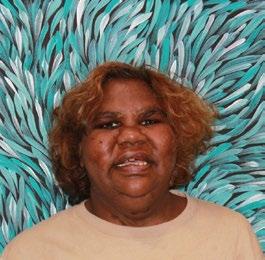
stories together in the one canvas.
Jeannie Mills
Pwerle is an Alyawarre speaker born in 1965. She was in the first group of Utopia women painters who put their stories onto canvas in 1989. Called The Summer Project the subsequent exhibition of these works set a new benchmark for the art of Utopia, launching the artists into what was to become a highly significant, multigenerational, and ongoing school of art. Jeannie is the daughter of the well-known artist, Dolly Mills and niece of the Utopia elder and acclaimed artist, Greeny Purvis Petyarre. Her main painting theme is the Bush Yam, or Anaty, - a staple food for many Utopia people as well an important dreaming story, celebrated in ceremonies by the Utopia women. A widely exhibited artist Jeanie was a finalist in the National Aboriginal and Torres Strait Islander Art Award in 2008 and her work is held in the collections of the National Gallery of Australia, the Holmes a Court collection and in many other private collections.
Lizzie Moss Pwerle was born in the early 1940s and is an Alyawarra woman from Atnwengerrp. She is a first cousin to Minnie Pwerle and was part of

Utopia’s early batik making projects. In her paintings Lizzie uses a series of intricate dots to portray the movement of Awelye –womens ceremony. The linear work indicates the lines that the women make in the red sand when they dance their stories that belong to Atnwengerrp country. Her work has been included in exhibitions in leading public and private galleries in Australia and internationally.
Rochelle Bird
Mbitjana was born in the early 1940s and is an Alyawarra woman from Atnwengerrp. She is a first cousin to Minnie Pwerle and was part of Utopia’s early batik making projects. In her paintings Lizzie uses a series of intricate dots to portray the movement of Awelye –womens ceremony. The linear work indicates the lines that the women make in the red sand when they dance their stories that belong to Atnwengerrp country. Her work has been included in exhibitions in leading public and private galleries in Australia and internationally.
Selina Teece
Pwerle was born in 1977 in her traditional country of Antarrengeny, which lies in Alyawarr country north of the Utopia region in
Central Australia. Selina grew up in the 1980s and 90s surrounded by famous artists of the Utopia school of painting and developed her own artistic talents at a very young age and is increasingly revealing a great versatility as an artist. Her painting themes range from depictions of gum blossoms and the leaves of the spinifex plant to landscapes that relate the stories from her father’s country Antarrengeny. Notable for its fine sense of colour and balanced design, Selina is dedicated to furthering her artistic career and is proving to be one of the most exciting newer talents of the younger generation artists of the Eastern Desert school of painting.


February 16-March 5, 2023
Salt Contemporary Art
33-35 Hesse Street, Queenscliff salt-art.com.au
